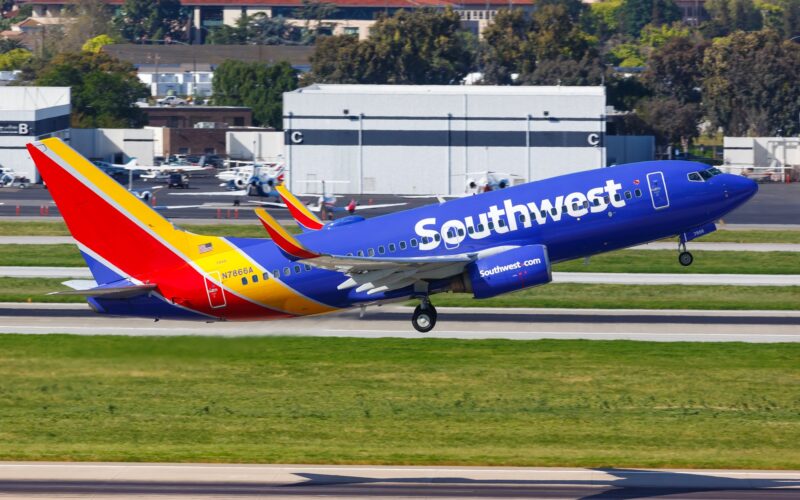The United States (US) National Transportation Safety Board (NTSB) has published the preliminary report about the near-miss incident at Austin Bergstrom International Airport (AUS), when a FedEx Boeing 767F freighter almost landed atop a Southwest Airlines Boeing 737-700.
On February 4, 2023, a FedEx Boeing 767F, registered as N297FE and operating flight FDX 1432, was coming into land at AUS. Meanwhile, Southwest Airlines’ Boeing 737-700, registered as N7827A, was on its take-off roll on flight SWA 708. According to the NTSB’s report, the “Austin Airport Air Traffic Control Tower (AUS ATCT) Air Traffic Manager (ATM) stated at the time of the incident, there was an extremely low traffic volume and complexity at AUS”.
Furthermore, “weather at the time of the incident was low instrument flight rules”, with calm winds, visibility at a quarter of a mile (400 meters), freezing fog, vertical visibility of 200 feet (60 meters), and temperature of -1°C (33.8°F).
At about 6:34 AM local time (UTC +6), the FedEx 767 pilots established contact with AUS’ ATC, which cleared the wide-body jet to conduct a CAT III instrument landing system (ILS) approach to runway 18L. The pilots acknowledged this information.
Then, at 6:38 AM local time (UTC +6), the Southwest Airlines’ First Officer checked in with the controller working at AUS, stating that they were holding short of the same runway where the FedEx freighter was cleared to land and were ready to take off. The ATC did indicate that the Boeing 767F was on a three-mile final approach and issued them takeoff clearance, and the FO correctly read back the information provided.
The Southwest Airlines 737 proceeded to taxi onto the runway, lined up with the runway centerline, and came to a complete stop to begin takeoff procedures. At this point, the first officer became the pilot flying (PF), as the captain handed over the controls to him. The first officer then advanced the power, checked the engines, and released the brakes to begin the takeoff roll.
FedEx and Southwest separated by 1,000 feet
It seems that the FedEx pilots saw the Southwest Airlines narrow-body jet on the runway and requested ATC to reaffirm that they were cleared for a landing on runway 18L.
The controller working at AUS affirmed that the Boeing 767 was cleared to land, advising of the traffic ahead of them, namely the Southwest Airlines aircraft. But at 6:40 AM local time (UTC +6), with FedEx on an approximately 0.7-mile (1.1 km) final approach, ATC asked whether the low-cost carrier’s aircraft was on its takeoff roll, with the 737’s pilots affirming that they were.
“According to the captain of FDX1432, he noted that at an altitude of about 150 feet (45.7 m), the FO called go-around after visually seeing SWA708 at approximately 1,000 feet to 1,500 feet (304.8 to 457.2 m) from the approach end of the runway,” the NTSB’s report continued. Shortly after, the FedEx crew called “Southwest abort” and subsequently stated on the radio frequency that “FedEx is on the go”.
“According to the SWA708 pilot narratives, the captain noted that somewhere between the speeds of 80 KIAS [Knots-indicated air speed – ed. note] and V1, he and the first officer heard FedEx call for a go-around,” the board’s preliminary inquiry stated.
Once the NTSB reviewed the preliminary Automatic Dependent Surveillance-Broadcast (ADS-B) data, the agency concluded that as FedEx’s Boeing 767 was at the departure end of the runway climbing out of 1,900 ft (579.1 m), ATC instructed the freighter’s crew to maintain 3,000 ft (914.4 m) of altitude. At the same time, as the Southwest Airlines Boeing 737 began to turn right, the narrow-body aircraft was 1,000 ft (304.8 m) lower than the cargo aircraft above it.
“The AUS ATCT ATM reported an overflight appeared to have occurred; however, the closest proximity has not yet been determined. SWA708 continued their flight plan route to Cancún, and FDX1432 executed a go-around and returned for landing without incident on runway 18L,” stated the NTSB’s report.
In a separate statement in February 2023, the NTSB’s chairwoman Jennifer Homendy indicated that the pair of aircraft could have been separated by an altitude of fewer than 100 ft (30.5 m).
To conduct its investigation, the NTSB called upon various parties, from the Federal Aviation Administration (FAA), FedEx, Southwest Airlines and the National Air Traffic Controllers Association (NATCA) to the Air Line Pilots Association, International (ALPA), Southwest Airlines Pilots Association (SWAPA), Boeing and Honeywell Aerospace. Furthermore, the NTSB formed groups to examine the relevant operations, human performance, ATC, meteorology, and the Flight Data Recorder (FDR).
The FAA provided the board with the ADS-B data and audio recordings from the day, as well as the digital FDRs and traffic alert and collision avoidance system (TCAS) computers. However, the Cockpit Voice Recorder (CVR) data had been overwritten, as they only save data for two hours.
Southwest Airlines and FedEx pilots spoke to the NTSB on the week starting February 13, 2023, while the Boeing 737’s TCAS unit’s information was downloaded three days later and is currently being analyzed.
No injuries were reported to the three crew members of the FedEx Boeing 767 or the 123 passengers and five crew members of the Southwest Airlines Boeing 737-700.

